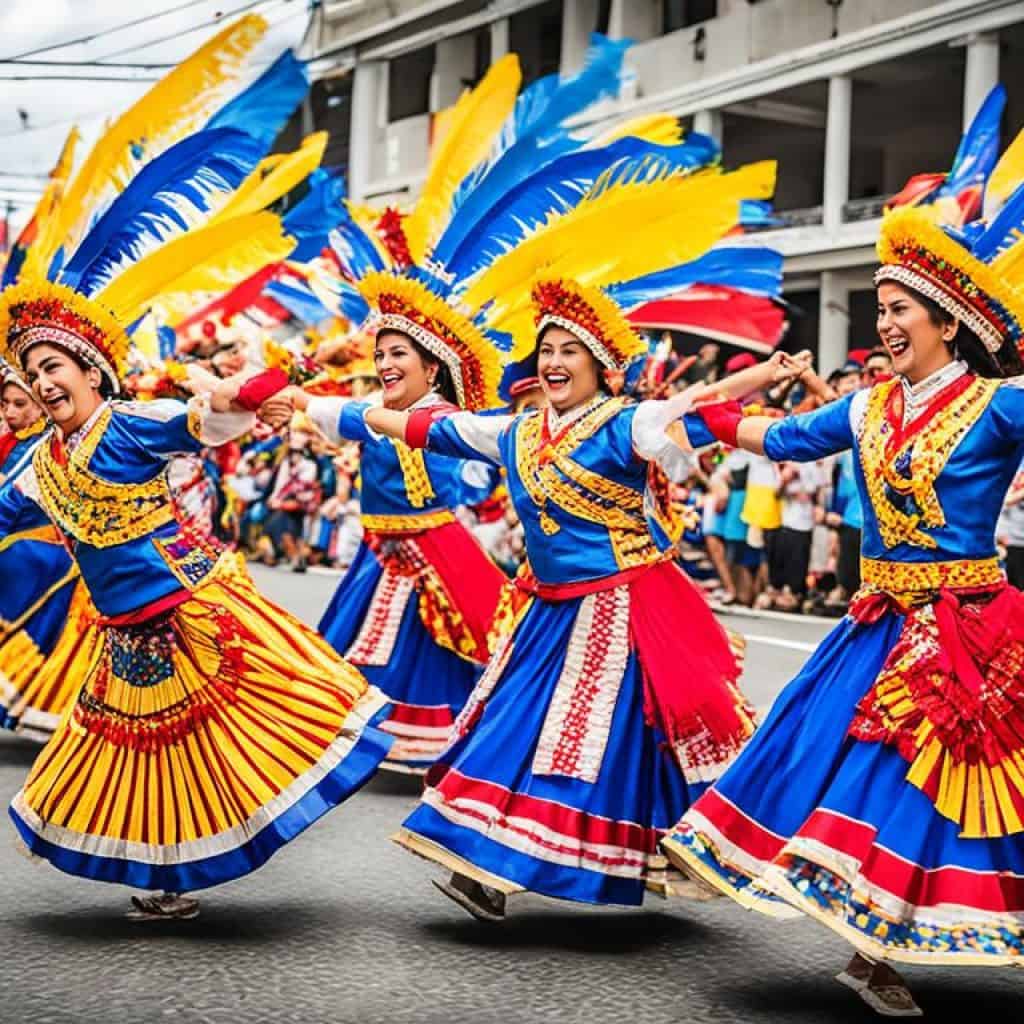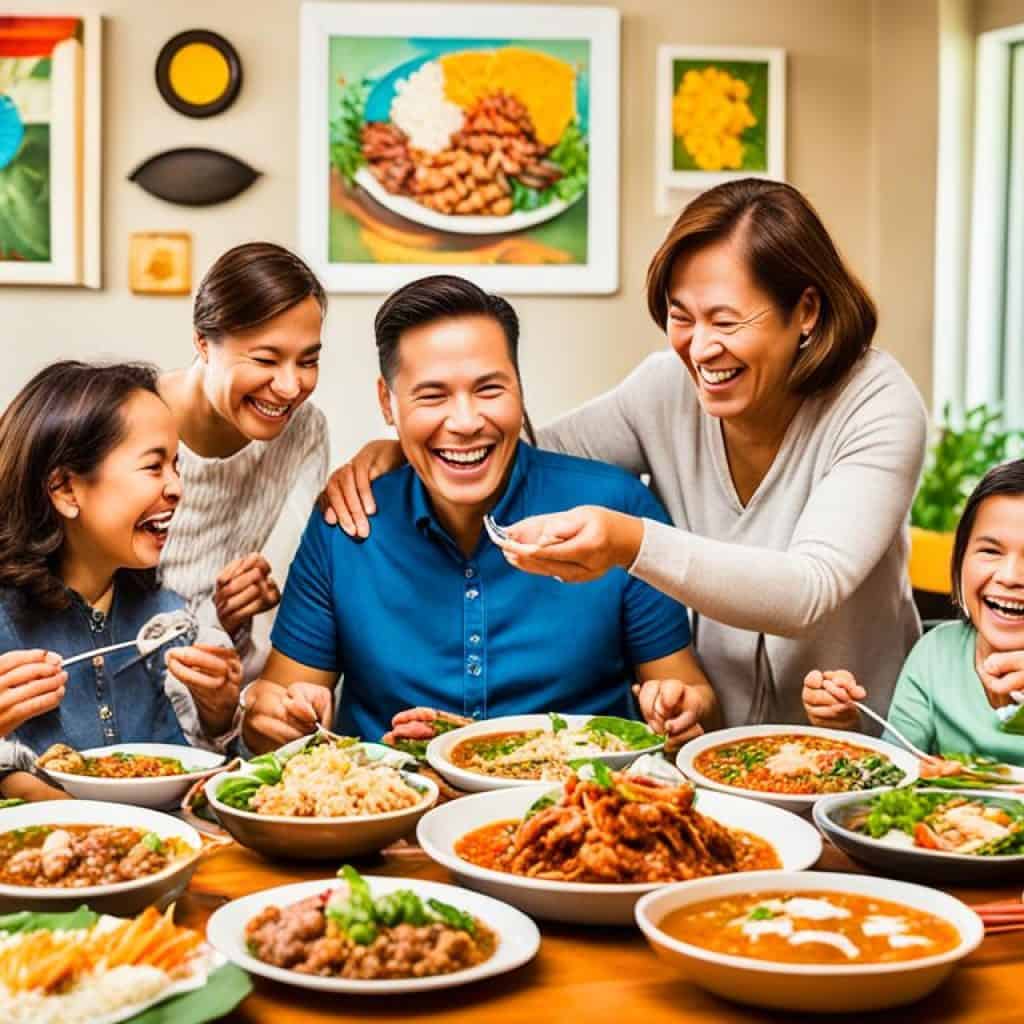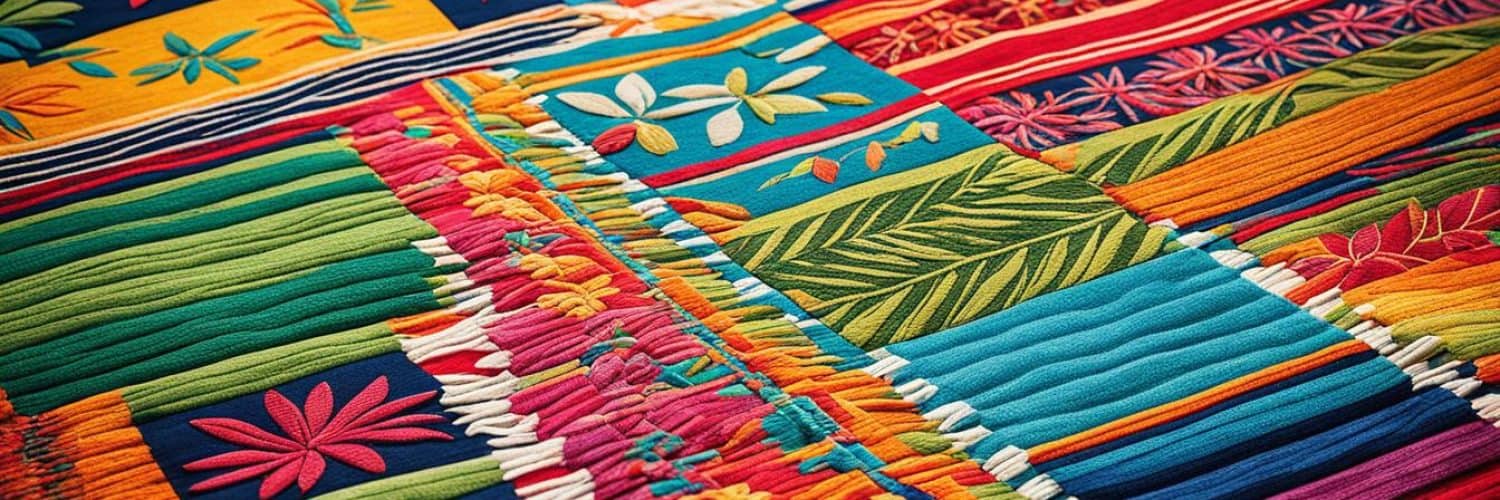The Philippines is much known for its vibrant culture. This includes delicious Filipino cuisine, colorful festivals, and strong family bonds. These unique traits set the Filipino people apart.
But what really makes their culture shine? How did their rich heritage influence their identity and values? Let’s find out.
In this article, we dive deep into the diverse culture of the Philippine people. We’ll explore their history, traditions, and the beauty of their land. Come along on this journey. Let’s celebrate the rich tapestry of the Filipino people together.
Key Takeaways:
- Discover the unique aspects of Filipino cuisine and the flavors that make it so beloved.
- Explore the resilience of the Filipino people and their ability to thrive in the face of adversity.
- Learn about the strong family ties that bind the Filipino community together.
- Immerse yourself in the vibrant festivals that showcase the beauty of Filipino traditions.
- Get a glimpse into the daily life of Filipinos and the customs that shape their way of life.
Resilience in the Face of Adversity
Filipinos are known for their resilience when facing hard times. Despite facing many disasters, they manage to overcome obstacles and stay positive. Their ability to get back up and handle tough times shows the deep-rooted resilience of Filipinos.
In the Philippines, disasters like typhoons and earthquakes are common. But Filipinos have a strong trait of disaster resilience. They have learned to adapt and keep going despite these issues.
When disasters happen, Filipinos unite to help each other. They support one another, offering assistance and comfort. This unity and shared strength mark Filipino resilience.
“In tough times, the Filipino spirit of resilience shines. We may fall, but we always get back up, stronger and more resolved than before.” – Maria Santos, a local resident.
This resilience goes beyond rebuilding after disasters. It’s about how Filipinos tackle daily life challenges. Overcoming obstacles and adapting is part of their everyday life.
Disaster Resilience: A Cultural Imperative
This amazing resilience comes from the Filipino spirit and cultural values. The Philippines faces many natural disasters because of its location. That’s why disaster resilience is a key part of its culture.
| Calamities in the Philippines | Year | Deaths | Estimated Damage (in millions USD) |
|---|---|---|---|
| Typhoon Haiyan (Yolanda) | 2013 | 6,300 | 3,000 |
| Mount Pinatubo Eruption | 1991 | 847 | 5,000 |
| Taal Volcano Eruption | 2020 | 0 | 102 |
| Bohol Earthquake | 2013 | 222 | 52 |
Filipinos’ skill in rebuilding after disasters shows their resilience. This ability is passed down through generations. It’s a cultural heritage that unites them as a nation.
Despite hardships, Filipinos stay hopeful and inventive. They have built a supportive community and organizations for disaster readiness and response. With efforts like the Bayanihan spirit and volunteering, they aim to build a disaster-resilient nation.
The Filipino resilience inspires other countries. It shows the strength of unity and community in hard times.
Family First: Strong Family Ties in the Philippines
Family is the core of Filipino culture. It includes not just immediate kin but also extended relatives and close friends. These strong bonds create a unified support network. Family traditions and gatherings help keep these bonds strong.
Filipino family values focus on extended relatives and tight connections. The idea of family includes aunts, uncles, cousins, and close friends. This sense of kinship fosters a supportive community.
Families in the Philippines come together for birthdays, holidays, and other events. These moments are cherished, strengthening ties and passing down traditions. It’s a way to keep family values alive through generations.
The Power of Filipino Family Values
The bonds in a Filipino family are a key part of their identity. They provide love, support, and a sense of belonging. When times get tough, families are the source of guidance and strength.
Family is not an important thing, it’s everything. – Michael J. Fox
In the Philippines, there’s always a network to lean on. The extended family plays a big role in raising children. This means both emotional and practical help whenever it’s needed.
Family traditions are vital in Filipino culture. These customs maintain the culture’s values and heritage. Whether it’s birthdays or religious holidays, traditions bring families closer.
A Visual Representation of Filipino Family Bonds
Family: The Building Block of Filipino Society
Strong family ties shape Filipino society. This close relationship fosters a welcoming community spirit. It’s a culture of generosity and hospitality.
Respect for elders is a key value. Adults often live with and care for aging parents. This ensures their well-being in later years.
This warmth extends to those outside the family too. Filipinos are known for treating guests like family. Visitors are warmly welcomed and invited to join in family events.
Filipino Cuisine: A Gastronomic Delight
Filipino cuisine is full of delicious flavors and rich traditions. It’s a must-try for everyone. This food brings together many cultures, including Malay, Chinese, Spanish, and American.
Adobo is a beloved dish in the Philippines. It’s made with meat marinated and cooked in vinegar, soy sauce, garlic, and spices. This creates a tangy and savory flavor that everyone loves.
Sinigang is a sour soup that’s very comforting. It uses tamarind for its sour taste. The dish also has vegetables, meat, or seafood, making it both sour and savory.
When talking about Filipino food, we must mention lechon. It’s a roasted pig that’s crispy on the outside and tender inside. Served often at celebrations, it’s eaten with liver sauce and sometimes with a cold drink.
“Filipino cuisine offers a unique blend of flavors and culinary traditions, making every meal an exciting experience.”
There’s something in Filipino cuisine for everyone. Street food lovers can try isaw (chicken or pork intestines), turón (banana spring rolls), or balut (boiled duck embryo). If you want a full meal, there’s sisig (sizzling pork dish) and kare-kare (oxtail stew in peanut sauce).
To truly understand Filipino food, you should try it yourself. Whether at a local restaurant, a fiesta, or a food market, you’ll get a taste of the country’s culture with every bite.
Preserving Traditions and Cultural Values
Filipinos deeply value their traditions and culture. They know the importance of keeping their unique identity alive. The bahay kubo and the pagmamano are practices passed through generations. These ensure Filipino traditions and values continue.
The bahay kubo showcases Filipino architecture and culture. Made of bamboo and nipa palm, it reflects a simple, sustainable way of life. It reminds Filipinos of their bond with nature, highlighting living in harmony with the environment.
Pagmamano is a traditional way to show respect to elders. One bows and touches an elder’s hand to their forehead. This gesture shows deep respect and thanks, important in Filipino family values.
“Preserving our traditions and cultural values is essential in keeping our identity alive. Through these customs, we maintain a sense of unity and pride in our Filipino heritage.” – Maria Hernandez, Cultural Preservation Advocate
Festivals play a big role in keeping Filipino traditions alive. They are a way to pass down practices from old to young. Events like Ati-Atihan and Panagbenga showcase the rich Filipino culture, drawing attention from everywhere.
Keeping Filipino traditions alive is a group effort. Families, communities, and organizations all have a part to play. Schools help too, by including cultural programs in their teaching. This way, the youth learns to value their heritage.
Festivals: A Colorful Celebration of Filipino Culture
The Philippines is famous for its colorful festivals. These festivals, like Sinulog in Cebu, Kadayawan in Davao, and Ati-Atihan in Kalibo, show the country’s rich culture. They feature lively parades, beautiful dances, and stunning costumes. These events are sure to amaze everyone who sees them.
Every January, the Sinulog Festival in Cebu brings the streets to life. It celebrates the Filipinos turning to Christianity and honors the Santo Niño. People wear bright costumes, dance to drum beats, and sing the Sinulog prayer.
The Kadayawan Festival in Davao thanks nature for its generous harvest. Local groups display their heritage with floats and dances. Visitors can also try Davao’s famous fruits and see the area’s diverse cultures.
The Ati-Atihan Festival honors the Philippines’ early history. People dress like the Aetas, native to Panay, and paint their faces. They dance and sing to drums, celebrating together.
Going to a Philippine festival is an amazing experience. It lets you dive into Filipino culture and traditions. You’ll see the people’s deep faith, enthusiasm, and creativity. These festivals reveal the heart of the nation and the strength of its people.
Don’t miss out on the lively atmosphere of Philippine festivals. Dive into the bright colors, joyful music, and rich traditions of Filipino culture.

Filipino Arts: Expressions of Creativity and Identity
The people of the Philippines love the arts. They enjoy traditional dances, paintings, and sculptures, which show off their rich culture. The Philippines is known for its literature, music, and visual arts. Filipino artists are celebrated around the world for their unique style and creative ideas.
Visual arts are very important in the Philippines. Artists create beautiful paintings, sculptures, and pottery. These pieces tell stories of daily life, historical events, and myths. Artists like Fernando Amorsolo and Juan Luna have wowed the world with their stunning works.
“Filipino arts celebrate the rich cultural heritage of the Philippines and serve as a powerful medium of self-expression.”
Dance is a colorful part of Filipino culture. Dancers wear vibrant costumes and show the beauty of the Philippines through their moves. The Tinikling, Singkil, and Pandanggo sa Ilaw are popular dances seen at festivals. They are not only fun but also keep Filipino traditions alive.
Music is a big deal in the Philippines, with different styles across the country. You’ll hear the kulintang, kubing, and banduria in traditional Filipino music. Modern music mixes local and Western sounds. Whether it’s folk songs or pop, Filipino music has fans everywhere.
Literature in the Philippines
Filipino literature is full of history, traditions, and values. It started even before the Spanish came, with epic poems and folklore. The Spanish brought new ideas, which led to famous writers like José Rizal and Nick Joaquin.
Today’s Filipino authors are exploring all kinds of stories. They write novels, short stories, poetry, and plays. They talk about society, culture, and personal experiences. Filipino literature is getting noticed worldwide, sharing Filipino life with everyone.
National Artists of the Philippines
The title of National Artist of the Philippines is a big honor. It goes to those who have greatly added to the country’s arts and culture. This includes artists from the visual arts, literature, music, theater, and cinema.
These national artists are celebrated for their incredible talent and their impact. Their work has not only made Filipino culture richer but has also gained international praise. They are true representatives of Filipino artistic heritage.
Filipino arts include a variety of creative ways to show the country’s culture. From visual arts and dance to music and literature, Filipino creativity is always growing. The work of Filipino artists shares the diverse stories and dreams of the Philippines with the whole world.
Religious Customs: The Role of Faith in Filipino Culture
Religion holds a special place in Filipino culture. The main faith is Catholicism. You can see churches and religious symbols everywhere in the Philippines. This shows how deeply Filipinos believe in their religion. Going to church and being part of religious events is common. These activities shape the values and customs of the Filipino community.
In the Philippines, religious festivals are a big deal. Festivals like the Santo Niño Festival and the Black Nazarene procession are key events. Here, Filipinos come together to show their faith and dedication. These festivals display the lively spirit and deep religious roots of the Filipino people.
The Santo Niño Festival in Cebu is a bright and happy event that honors the child Jesus. It has street parades, traditional dances, and colorful costumes. This makes for an environment filled with religious excitement. Meanwhile, the Black Nazarene procession in Manila draws millions. They come to pay homage to the Black Nazarene statue, believed to work miracles.
In the Philippines, churches are important to the community. They range from small chapels to big cathedrals. These worship places are not just important for religion but also as architectural wonders. They combine indigenous, Spanish, and modern styles. This mirrors the diverse cultural background of the country.
Religious customs are a big part of daily life for Filipinos. Besides going to church, Filipinos often join in novenas, processions, and pilgrimages. These practices strengthen their bond with their faith. They also give them a feeling of community and spiritual fulfillment.
Religion in the Philippines is more than just belief; it’s a lifestyle. It affects all parts of Filipino culture. It shapes their values, traditions, and how they see the world.
Religious customs in the Philippines show the strong faith and spiritual devotion of the Filipino people. These traditions have been handed down through generations. They serve as a source of strength and togetherness when facing life’s difficult moments. From religious festivals to church activities, religion remains key in defining the Filipino community’s cultural identity.
The Filipino Language: A Reflection of Identity
The Filipino language, known as Tagalog, is the Philippines’ national language. The country also hosts various regional languages and dialects. This shows the Filipino people’s linguistic diversity. Language is vital in expressing identity and heritage. It’s something Filipinos are proud of, especially their skill in speaking multiple languages. The Filipino language brings people from different areas together.
Tagalog is spoken across the Philippines. It’s used in government and education, showing its role in culture and identity. But, the Philippines is full of many languages, with over 170 dialects. These include Cebuano, Ilocano, and Hiligaynon. They add to the country’s language richness.
“Language is the road map of a culture. It tells you where its people come from and where they are going.” – Rita Mae Brown
The country’s varied languages reflect its multicultural past. Colonizers and traders, like the Spanish and Americans, influenced the Philippines. They brought different languages and dialects. This made the Filipino culture linguistically rich.
Speaking many languages is valued in the Philippines. It’s common for Filipinos to know English, Tagalog, and a regional language. This skill shows their willingness to embrace various cultures. It also helps them connect with people from different backgrounds.
The Filipino language unites the nation. It allows people to communicate and understand each other. This language helps share thoughts and experiences, crossing regions and cultures.
Celebrating Linguistic Diversity in the Philippines
Philippines’ linguistic diversity is celebrated. One major event is Buwan ng Wika (Language Month) in August. Schools and groups hold activities then. They encourage the Filipino language and other regional dialects.
Language carries cultural heritage. It preserves traditions through stories and songs. Protecting languages helps keep Filipino culture alive. Language and culture are deeply linked.
The Future of Language and Cultural Identity
The Filipino language faces challenges in today’s global society. English and other languages are becoming more popular. But, there’s a strong will to keep Filipino languages alive.
Work is happening to save endangered languages. Communities and experts are creating programs and tools for language learning. This encourages the use of regional dialects.
In summary, the Filipino language is a key part of the nation’s culture. It helps maintain the country’s diverse heritage. Even as the world changes, this language unites Filipinos. By keeping their language alive, Filipinos ensure their culture will last for future generations.
Exploring the Philippines: Travel and Tourism
The Philippines is a tropical paradise with breathtaking landscapes and pristine beaches. It’s a favorite spot for travelers worldwide. From Boracay’s white sands to Palawan’s underground river and Siargao’s surfing spots, there’s something for everyone.
Nature lovers will be enchanted by the Philippines’ wonders. You can see Banaue’s stunning rice terraces, known as the “Eighth Wonder of the World”. Or dive into Tubbataha Reefs Natural Park’s clear waters. It’s a UNESCO site full of vibrant marine life.
The country has lush rainforests, majestic waterfalls, and magnificent volcanoes too. All waiting for you to explore.
Adventure seekers will find thrilling activities in the Philippines. Try hiking, caving, zip-lining, and canyoneering. Reach the top of Mount Apo or explore Sagada’s caves. Whether it’s mountains or rapids, there’s an adventure here for you.
“The Philippines is a traveler’s paradise. With stunning places, cultural heritage, and warm people, there’s something for everyone. Whether it’s relaxing on the beach, seeking thrills, or exploring history and culture.” – Travel enthusiast
History buffs will love the Philippines’ historical sites. Visit Intramuros in Manila, dating back to Spanish times, to see Filipino and Spanish influences. Or explore Vigan City to see well-preserved Spanish architecture. Each site shows the Philippines’ rich heritage.
Don’t miss the Philippines’ famous beaches. Boracay’s white sand and blue waters are must-sees. Palawan’s El Nido and Coron have amazing cliffs and snorkeling spots. Siargao is known worldwide for surfing.
Celebrating Filipino Hospitality
The Philippines is also known for its warm hospitality. The Filipino people are friendly and welcoming. They’re proud to share their culture and traditions with visitors, making you feel like family.
Exploring cities like Manila or remote islands, you’ll find smiles everywhere. From when you arrive until you leave, Filipino hospitality makes your visit unforgettable.
Plan Your Adventure in the Philippines
The Philippines has a wide range of destinations for all. With beautiful beaches, stunning landscapes, and rich culture, it’s a place of discovery and adventure.
So, pack your bags, and dive into the Philippines’ beauty. Whether you seek relaxation, adventure, or cultural exploration, the Philippines awaits to welcome you.
Filipino Traditions in Daily Life
Filipino everyday life features a rich mix of customs passed down for generations. These traditions create a special lifestyle rooted in culture. Customs like superstitions, family gatherings, and fiestas define Filipino identity.
Superstitions and Beliefs
Superstitions are big in Filipino life. They shape actions and rituals, aiming to bring luck or avoid bad fortune. For instance, not sweeping at night to avoid bad luck, or placing money in pockets for prosperity. These superstitions bring mystery and keep traditions alive.
Family Gatherings
Family stands at the heart of Filipino society. Family events are crucial, emphasizing strong ties. Regular meetings celebrate life, share meals, and enjoy unity. This reinforces kinship, love, and support.
Fiestas: Celebrating Life and Community
Fiestas are colorful events that unite communities. They honor saints or historical events with parades, dances, and food. This festive atmosphere is magical. Fiestas showcase cultural heritage, build bonds, and express gratitude.
“Fiestas are not just events; they are a way of life for Filipinos, embodying the spirit of joy, camaraderie, and gratitude.”
The Practice of Pagmamano
Pagmamano is a sign of respect in Filipino life. It involves touching an elder’s hand to the forehead. This practice emphasizes respect and the value of elders. It reminds us to honor our heritage.
A Glimpse into Filipino Daily Life
Exploring Filipino traditions reveals a unique lifestyle. It shows how customs impact daily routines. From morning greetings to family meals and superstitions, these shape Filipino identity and unity.

In cities and provinces, Filipino life is rich with traditions that respect history and celebrate the present. This unique culture is fascinating and full of hope for the future.
Influences of Colonization: Spanish and American Legacies
The Philippines has a rich history marked by Spanish and American colonization. These periods influenced its culture deeply. The Spanish rule brought Catholicism and impacted the country’s language, arts, and traditions for over three centuries.
“The Spanish colonization deeply influenced the religious scene in the Philippines. Catholicism became a big part of Filipino culture. This change affected society’s values and rituals,” said Dr. Maria Santos, a cultural historian.
Under Spanish influence, Filipinos adopted Catholicism. They blended it with their indigenous beliefs and practices. Spanish architecture and design are evident in many churches and heritage sites today.
The Americans came in the late 19th century, starting a new colonial era. They made English an official language and modernized the Philippines. This period brought changes in social, political, and economic aspects.
“American influence led to improvements in education, infrastructure, and governance. It also caused cultural assimilation, with Filipinos adopting American ways,” explained Dr. Miguel Reyes, a cultural anthropologist.
English became widely used, influencing literature, music, and entertainment in the Philippines. The American period introduced new technologies. This revolutionized Filipino lifestyles.
The mix of Spanish and American colonial legacies has created a unique blend in Filipino culture. Catholicism, Spanish architecture, English language, and modernization mark the country’s identity. These influences shape the Philippines today.
The Continuing Legacy of Spanish and American Influences
The period of colonization blended Filipino traditions with Spanish and American influences. Filipino culture today shows this fusion. It’s seen in language, religion, cuisine, arts, and celebrations.
Spanish colonization’s legacy is visible in the Catholic faith dominating the Philippines. Religious festivals and dishes like adobo and lechon carry Spanish influences.
Meanwhile, American influences are seen in education, politics, and popular culture. English is widely used and part of the Filipino identity.
Despite colonization, Filipinos have kept their unique cultural identity. They have balanced tradition and modernity. The rich cultural mix shows the resilience and adaptability of the Filipino people.
| Spanish Influence | American Influence |
|---|---|
| Introduction of Catholicism | Modernization and infrastructure development |
| Influence on language and religious practices | English as an official language |
| Spanish architectural styles and designs | Advancements in education and governance |
| Spanish culinary influences | Influence on Philippine literature and entertainment |
The cultural heritage of the Philippines highlights the resilience and adaptability of its people. They’ve embraced various influences while maintaining a unique cultural identity.
Respecting Cultural Heritage: Preservation and Revival
The Philippines takes cultural preservation very seriously. The country protects crafts, traditions, and historical spots that show its rich culture. Museums and cultural organizations work hard to keep Filipino heritage alive.
By valuing cultural diversity, the Philippines makes sure its unique culture will be enjoyed by the future. This is vital for keeping Filipino traditions authentic and vibrant.
Preservation of Traditional Crafts
Traditional crafts are central to Filipino culture. They showcase the creativity and history of the Filipino people. The country works to keep these crafts alive as important cultural assets. Artisans are supported to continue their crafts and teach the next generation.
Traditional crafts like weaving, pottery, and woodcarving highlight the skill of Filipino artisans. These crafts are more than just decorations; they carry the cultural stories of various regions in the Philippines.
Reviving Indigenous Traditions
Many indigenous communities call the Philippines home. Each has its own traditions and languages. Despite challenges, there are strong efforts to keep these traditions alive.
Local groups, NGOs, and cultural bodies work together to help indigenous people. They organize festivals and workshops to share and celebrate indigenous cultures.
The Importance of Historical Site Conservation
Historical sites offer a glimpse into the past. They help us understand the country’s historical and cultural growth. The Philippines is committed to preserving these places for future generations.
Restoring historical buildings, like churches and forts, is a big focus. These efforts not only save historical sites but also support cultural tourism. This helps the local economy and increases heritage awareness.
“Historical sites connect us to our cultural roots. Preserving them lets us learn from the past and inspire future generations.”
The Role of Education and Awareness
Education and awareness are key in keeping cultural heritage alive. The Philippines includes cultural studies in school and promotes heritage through media. The goal is to build pride and respect for Filipino traditions.
Partnerships across sectors help sustain cultural preservation. These partners support research and share knowledge about cultural traditions. Together, they help keep Filipino culture strong.
Respecting and preserving cultural heritage is a priority in the Philippines. These actions ensure the country’s traditions and values are celebrated and passed on. The Philippines celebrates its culture, making it a vibrant and diverse nation.
Filipino Community: Pinoy Pride and Global Influence
Millions of Filipinos live and work overseas, far from the Philippines. They are a big part of the Filipino diaspora. These overseas Filipino workers are often seen as modern heroes, important to the global economy.
Though far from home, these workers keep their Filipino heritage alive. Carrying their Pinoy pride, they unite with fellow Filipinos abroad. They share Filipino customs, music, food, and traditions through events and organizations.
“Wherever you go, there’s always a part of the Philippines with you. Our heritage, our values, and our sense of community unite us and shape our identity as Filipinos,” says Maria Santos, an overseas Filipino worker living in the United States.
The Filipino community has a big global influence. Their pride shines at international events, showcasing Philippine culture. Audiences worldwide love the music, dance, and food of the Philippines.
The global Filipino community acts as culture ambassadors. They help understand different cultures and bridge gaps. Their actions make the world more inclusive and interconnected. This inspires pride in Filipino heritage among future generations.
The Future of Filipino Culture: Embracing Diversity and Innovation
Filipino culture is changing fast due to modernization and globalization. This change brings new ideas to Filipino society. It helps create innovative ideas and practices in Filipino culture.
The youth in the Philippines are key to preserving and evolving Filipino culture. They blend tradition with new technologies. Their efforts help celebrate Filipino heritage in new ways.
“The Filipino youth are the torchbearers of our cultural heritage. They possess the creativity and adaptability to ensure that our traditions thrive in the modern world.”
Cultural exchange programs make Filipino culture lively. The Philippines invites people from all over to share its culture. These exchanges deepen appreciation for Filipino customs and bring new ideas.
Innovation in Filipino Arts and Music
The arts and music in the Philippines are becoming more creative and varied. Dance, art, and music mix traditional and modern elements. This fusion creates new and exciting forms of Filipino arts.
- Fusion of Traditional and Modern Dance: Dance companies combine traditional Filipino styles with modern moves. Their performances are bold and break new ground.
- Exploration of New Sounds: Filipino musicians blend different styles and instruments. This mix creates a unique sound in their music.
Culinary Innovation: A Taste of the Future
Filipino food is also innovating. Chefs and food creators are mixing in worldwide flavors and methods. They make dishes that show the evolving tastes of Filipinos.
“Filipino cuisine is a dynamic and ever-evolving mosaic that reflects the diverse cultures and influences that have shaped our nation. The fusion of traditional flavors with global culinary trends opens doors to a vibrant and delicious future.”
- Modern Interpretations of Traditional Dishes: Chefs reinvent traditional Filipino meals with new ingredients and methods. Their dishes offer a twist on the classics.
- Cross-Cultural Fusion: Filipino chefs work with chefs from other countries. Together, they create fusion dishes that spotlight the best of both worlds.
The future of Filipino culture looks vibrant. Diversity, innovation, and cultural exchange are shaping its path. As Filipinos hold on to their heritage and adapt, their traditions stay alive and valued.
Conclusion
The rich culture of the Filipino people showcases their diverse heritage and vibrant traditions. They stand strong through hard times. They also cherish celebrations and the bonds of family. This unique lifestyle is deeply woven into their cultural identity.
The blend of various influences has shaped Filipino traditions, cuisine, arts, and language. Their culture is like a mosaic, full of different customs and beliefs. It highlights the country’s diversity and strength.
Looking ahead, the Philippines is keeping its rich culture alive while adapting to new changes. The youth are key in this, mixing tradition with new ideas. Efforts in cultural preservation and exchange keep Filipino culture alive and dynamic.
This strong identity and pride are clear among Filipinos worldwide. They share their rich cultural traditions everywhere they go. It keeps their heritage vibrant across the globe.
Exploring Filipino culture, from food and festivals to arts and religion, helps us appreciate their beauty and diversity. Their unique identity comes from mixing many cultural influences together. As the world grows closer, Filipino culture also evolves.
It embraces both diversity and new ideas while keeping its roots. The deep traditions, strong family values, and lively celebrations of Filipino culture continue to enchant and inspire people globally.
FAQ
What is the culture of the Filipino people like?
How do Filipinos show resilience in the face of adversity?
What is the importance of family in Filipino culture?
What is Filipino cuisine known for?
How do Filipinos preserve their traditions and cultural values?
What are some of the vibrant festivals in the Philippines?
How does Filipino culture embrace the arts?
What role does religion play in Filipino culture?
What languages are spoken in the Philippines?
What are some popular travel destinations in the Philippines?
What are some everyday traditions in Filipino culture?
How have colonization influenced Filipino culture?
How does the Philippines preserve its cultural heritage?
How does the Filipino community contribute to global culture?
How does Filipino culture adapt to modernization and globalization?
What is the significance of Filipino culture and heritage?
Source Links
- https://theculturetrip.com/asia/philippines/articles/11-things-you-should-know-about-the-filipino-culture
- https://www.britannica.com/place/Philippines/Cultural-life
- https://medium.com/@shielamarieandres17/title-unraveling-the-rich-tapestry-of-filipino-culture-a-journey-through-the-philippines-unique-abea1d640381







Add comment